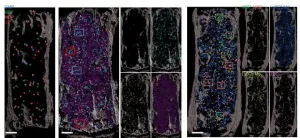(Press-News.org) Global emissions of a potent substance notorious for depleting the Earth's ozone layer - the protective barrier which absorbs the Sun's harmful UV rays - have fallen rapidly and are now back on the decline, according to new research.
Two international studies published today in Nature, show emissions of CFC-11, one of the many chlorofluorocarbon (CFC) chemicals once widely used in refrigerators and insulating foams, are back on the decline less than two years after the exposure of their shock resurgence in the wake of suspected rogue production.
Dr Luke Western, from the University of Bristol, a co-lead author of one of the studies, said: "The findings are very welcome news and hopefully mark an end to a disturbing period of apparent regulatory breaches. If the emissions had stayed at the significantly elevated levels we found, there could have been a delay, possibly of many years, in ozone layer recovery. On top of that, since CFC-11 is also a potent greenhouse gas, the new emissions were contributing to climate change at levels similar to the carbon dioxide emissions of a megacity."
The production of CFC-11 was banned globally in 2010 as part of the Montreal Protocol, a historic international treaty which mandated the phase-out of ozone-depleting substances. Thereafter, CFC-11 emissions should have steadily fallen.
But in 2018 some of the same scientists behind the recent more reassuring discovery found a jump in emissions had begun around 2013, prompting alarm at the time that production of the banned substance had resumed in an apparent violation of the Montreal Protocol.
The first sign of something untoward was spotted by an international atmospheric monitoring team led by the National Oceanic and Atmospheric Administration (NOAA).
Dr Steve Montzka from NOAA, lead author of the original research paper explained: "We noticed the concentration of CFC-11 had declined more slowly since 2013 than predicted, clearly indicating an upturn in emissions. The results suggested that some of the increase was from eastern Asia."
These unexpected findings were confirmed by an independent global measurement network, the Advanced Global Atmospheric Gases Experiment (AGAGE).
Professor Ron Prinn from Massachusetts Institute of Technology (MIT), AGAGE principal investigator and co-author of both new papers, said: "The global data clearly suggested new emissions. The question was where exactly?
"The answer lay in the measurements at AGAGE and affiliate monitoring stations that detect polluted air from nearby regions. Using data from Korean and Japanese stations, it appeared around half of the increase in global emissions originated from parts of eastern China."
Further investigation by media and environmental campaigners exposed usage of CFC-11 in the manufacture of insulating foams in China. Chinese authorities took notice and at meetings of the Montreal Protocol in 2018 and 2019, they confirmed some banned ozone depleting substances were identified during factory inspections, but only in very small amounts relative to those inferred from the atmospheric data. According to their reports, arrests, material seizures, and the demolition of production facilities ensued.
The scientific teams have continued to closely monitor atmospheric levels, and the latest evidence, reported in the two papers on global CFC-11 emissions and eastern Chinese emissions, indicates that those efforts have likely contributed to dramatic emission declines.
Professor Matt Rigby, from the University of Bristol, co-author of both studies, explained: "To quantify how emissions have changed at regional scales, we compared the pollution enhancements observed in the Korean and Japanese measurement data to computer models simulating how CFC-11 is transported through the atmosphere. With the global data, we used another type of model that quantified the emissions change required to match the observed global CFC-11 concentration trends.
"At both scales, the findings were striking; emissions had dropped by thousands of tonnes per year between 2017 and 2019. In fact, we estimate this recent decline is comparable or even greater than the original increase, which is a remarkable turnaround."
Whilst the findings suggest the rapid action in eastern China and other regions of the world has likely prevented a substantial delay in ozone layer recovery, any unreported production will have a lingering environmental impact.
Professor Rigby added: "Even if the new production associated with the emissions from eastern China, and other regions of the world, has now stopped, it is likely only part of the total CFC-11 that was made has been released to the atmosphere so far. The rest may still be sitting in foams in buildings and appliances and will seep out into the air over the coming decades."
Since the estimated eastern Chinese CFC-11 emissions could not fully account for the inferred global emissions, there are calls to enhance international efforts to track and trace any future emitting regions.
Professor Ray Weiss, from Scripps Institution of Oceanography, a Principal Investigator in AGAGE, said: "As a direct result of these findings, the Parties of the Montreal Protocol are now taking steps to identify, locate and quantify any future unexpected emissions of controlled substances by expanding the coverage of atmospheric measurements in key regions of the globe."
INFORMATION:
Papers
'A decline in emissions of CFC-11 and related chemicals from eastern China' by Park et al in Nature
'A decline in global CFC-11 emissions during 2018-2019' by Montzka et al in Nature
When we tear a muscle " stem cells within it repair the problem. We can see this occurring not only in severe muscle wasting diseases such as muscular dystrophy and in war veterans who survive catastrophic limb injuries, but also in our day to day lives when we pull a muscle.
Also when we age and become frail we lose much of our muscle and our stem cells don't seem to be able to work as well as we age.
These muscle stem cells are invisible engines that drive the tissue's growth and repair after such injuries. But growing these cells in the lab and then using them to therapeutically replace damaged muscle has been frustratingly difficult.
Researchers at the Australian Regenerative Medicine Institute at Monash University in Melbourne, ...
Researchers at the Centre for Genomic Regulation (CRG) reveal that newly formed embryos clear dying cells to maximise their chances of survival. It is the earliest display of an innate immune response found in vertebrate animals to date.
The findings, which are published today in the journal Nature, may aid future efforts to understand why some embryos fail to form in the earliest stages of development, and lead to new clinical efforts in treating infertility or early miscarriages.
An embryo is fragile in the first hours after its formation. Rapid cell division and environmental stress make them prone to cellular errors, which in turn cause the sporadic death of embryonic stem cells. This is ...
For nearly a century, scientists have worked to unravel the mystery of dark matter--an elusive substance that spreads through the universe and likely makes up much of its mass, but has so far proven impossible to detect in experiments. Now, a team of researchers have used an innovative technique called "quantum squeezing" to dramatically speed up the search for one candidate for dark matter in the lab.
The findings, published today in the journal Nature, center on an incredibly lightweight and as-of-yet undiscovered particle called the axion. According to theory, axions are likely billions to trillions of times smaller than electrons and may have been created during the Big Bang in humungous numbers--enough ...
What The Study Did: This observational study describes differences in the number of COVID-19 deaths by nursing home racial composition and examines the factors associated with these differences.
Authors: Rebecca J. Gorges, Ph.D., of the University of Chicago, is the corresponding author.
To access the embargoed study: Visit our For The Media website at this link https://media.jamanetwork.com/
(doi:10.1001/jamanetworkopen.2020.37431)
Editor's Note: The article includes funding/support disclosures. Please see the article for additional information, including other authors, author contributions and affiliations, conflict of interest ...
What The Study Did: This article revisits the role of dermatologists in the early HIV/AIDS epidemic for the 40th anniversary of the epidemic.
Authors: Heather Milbar, M.D., M.P.H., of the University of Pennsylvania in Philadelphia, is the corresponding author.
To access the embargoed study: Visit our For The Media website at this link https://media.jamanetwork.com/
(doi:10.1001/jamadermatol.2020.5545)
Editor's Note: Please see the article for additional information, including other authors, author contributions and affiliations, conflict of interest and financial disclosures, and funding and support.
INFORMATION:
Media ...
What The Study Did: Researchers examined changes in how organ donation from deceased donors differed by race and ethnicity in the United States over time.
Authors: Dorry L. Segev, M.D., Ph.D., of the Johns Hopkins University School of Medicine in Baltimore, is the corresponding author.
To access the embargoed study: Visit our For The Media website at this link https://media.jamanetwork.com/
(doi:10.1001/jamasurg.2020.7083)
Editor's Note: The article includes conflicts of interest and funding/support disclosures. Please see the article for additional information, including other authors, author contributions and affiliations, conflict of interest and financial disclosures, and funding and support.
INFORMATION:
Media advisory: The full study is linked to this news ...
Researchers in Southampton and San Francisco have developed the first compact 3D LiDAR imaging system that can match and exceed the performance and accuracy of most advanced, mechanical systems currently used.
3D LiDAR can provide accurate imaging and mapping for many applications; it is the "eyes" for autonomous cars and is used in facial recognition software and by autonomous robots and drones. Accurate imaging is essential for machines to map and interact with the physical world but the size and costs of the technology currently needed has limited LIDAR's use in ...
CINCINNATI--Imagine a day when clinicians treating people with blood diseases such as leukemia or multiple myeloma can send in requests for laboratories to custom-produce specific types of blood cells to replace those affected by the disease.
That day became one step closer to reality with a new study led by experts at Cincinnati Children's that provides powerful new insights into how bone marrow tissue works.
The study, published Feb. 10, 2021 in Nature, was led by senior author Daniel Lucas, PhD, and first authors Jizhou Zhang, MD, and Qingqing Wu, PhD, from the Division of Experimental Hematology and Cancer Biology. Co-authors include a team of scientists from Cincinnati Children's and the University of Cincinnati, plus collaborators in Colorado, Texas and Michigan.
The ...
Imaging planets orbiting around nearby stars, which could potentially harbour life, has become a possibility thanks to the progress made in observational methods by an international team of astronomers. First candidate: Alpha Centauri, a system similar to ours, "only" 4.3 light years away. This study is the subject of a publication in the journal Nature Communications.
Efforts to obtain direct images of exoplanets - planets outside our solar system - have so far been hampered by technological limitations, which have led to a bias towards detecting planets much larger than Jupiter, around very young stars and far from the habitable zone, the area in which a planet may have liquid water on its surface, and thus ...
Researchers from the University of Seville's Nursing Department, with the collaboration of professionals from the ICU at Virgen Macarena University Hospital in Seville, have analysed the key factors in caring for critical COVID-19 patients during the first wave of the pandemic. Their study concludes that nursing care was impacted by fear and isolation, which made it difficult to maintain the human experience of health care.
The break down in the humanising trend of ICU care during this period was mainly the result of the isolation of COVID-19 patients. This, along with the personal protection equipment worn by staff to prevent becoming infected ...



